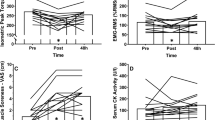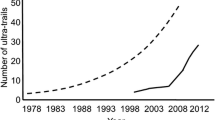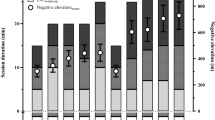Summary
Nine men volunteered to undergo 10% downhill (DT) or 10% uphill (UT) treadmill training at 60% \(\dot V_{O_{2max} } \) for 12 minutes on two consecutive days. Four days later the downhill run (DR) was repeated. All subjects reported considerable muscular soreness following DT but not UT. When DR followed UT muscular soreness was again reported but not when DR followed DT. Peak knee flexion and extension moment of force data at five angular velocities, ranging from 0.52–4.71 rad s−1, were reduced following DR regardless of whether soreness was present. During each run \(\dot V_{O_2 } \) was stable during UT but drifted upwards during DT and DR. This increase in \(\dot V_{O_2 } \) was not due to changes in the stride frequency since the stride frequency remained nearly constant on all days except for the second day of the DT when an increase of 20 strides per minute occurred; this was the only day the subjects ran while sore. It was concluded that two 12 minute bouts of downhill running were sufficient to protect against the occurrence of muscular soreness in subsequent downhill run. However, this training was insufficient to prevent a 2–3 day loss of muscular strength. These results support the hypothesis that the sensation of delayed onset muscle soreness and the temporary strength loss associated with eccentric contraction have different physiological causes.
Similar content being viewed by others
References
Armstrong RB (1984) Mechanisms of exercise induced delayed onset soreness: a brief review. Med Sci Sports Exerc 16: 529–538
Armstrong RB, Ogilvie RW, Schwane JA (1983) Eccentric exercise-induced injury to rat skeletal muscle. J Appl Physiol: Respirat Envir Exerc Physiol 54: 80–93
Balke B, Ware RW (1959) An experimental study of fitness of Air Force Personnel. US Armed Forces Med J 10: 675
Byrnes WC, Clarkson PM, White JS, Hsieh SS, Frykman PN, Maughan RJ (1985) Delayed onset muscle soreness following repeated bouts of downhill running. J Appl Physiol 59: 710–715
Friden J (1984) Muscle soreness after exercise: Implications of morphological changes. Int J Sports Med 5: 57–66
Friden J, Seger J, Sjostrom M, Ekblom B (1983) Adaptive response in human skeletal muscle subjected to prolonged eccentric training. Int J Sports Med 4: 177–183
Hannon PM, Rasmussen SA, DeRosa CP (1985) Electromyographic patterns during level and inclined treadmill running and their relationship to step cycle measures. Res Quart Exerc Sport 56: 334–338
Howell JN, Chila AC, Fort G, David D, Gates T (1985) An electromyographic study of elbow motion during postexercise muscle soreness. J Appl Physiol 58: 1713–1718
Komi PV, Buskirk ER (1972) Effect of eccentric and concentric muscle conditioning on tension and electrical activity on human muscle. Ergonomics 15: 417–434
Komi PV, Viitasalo JT (1977) Changes in motor unit activity and metabolism in human skeletal muscle during and after repeated eccentric and concentric contractions. Acta Physiol Scand 100: 246–254
McCully KK, Faulkner JA (1985) Injury to skeletal muscle fibers of mice following lengthening contractions. J Appl Physiol 59: 119–126
Neeves RE, Barlow DA (1974) Simultaneous considerations of physiological and biomechanical changes occurring in female runners during negative and positive treadmill running. Proceedings of the 1st Annual Meeting of the Canadian Society of Biomechanics. Hayes KC, Norman RW (eds). Edmonton, Alberta
Newham DJ, Mills KR, Quigley BM, Edwards RHT (1983) Pain and fatigue after concentric and eccentric muscle contractions. Clin Sci 64: 55–62
Sale DG, Norman RW (1982) Testing strength and power. In: MacDougal JD, Wenger HA, Green HJ (eds) Physiological testing of the elite athlete. Canadian Association of Sports Sciences, Ottawa, pp 7–37
Schwane JA, Armstrong RB (1983) Effect of training on skeletal muscle injury from downhill running in rats. J Appl Physiol: Respirat Envir Exerc Physiol 55: 969–975
Schwane JA, Johnson SR, Vandenakker CB, Armstrong RB (1983) Delayed onset muscular soreness and plasma CPK and LDH activities after downhill running. Med Sci Sports Exerc 15: 51–56
Tiidus PM, Ianuzzo CD (1983) Effects of intensity and duration of muscular exercise on delayed soreness and serum enzyme activities. Med Sci Sports Exerc 15: 461–465
Author information
Authors and Affiliations
Rights and permissions
About this article
Cite this article
Pierrynowski, M.R., Tüdus, P.M. & Plyley, M.J. Effects of downhill or uphill training prior to a downhill run. Europ. J. Appl. Physiol. 56, 668–672 (1987). https://doi.org/10.1007/BF00424808
Accepted:
Issue Date:
DOI: https://doi.org/10.1007/BF00424808




